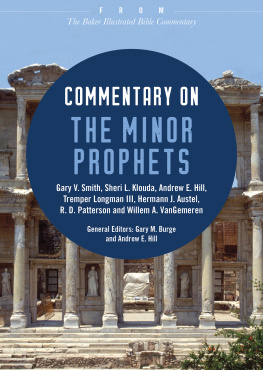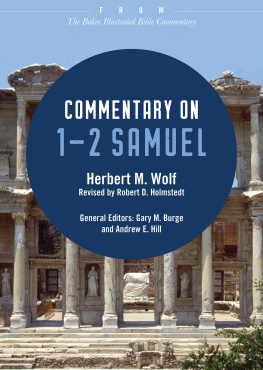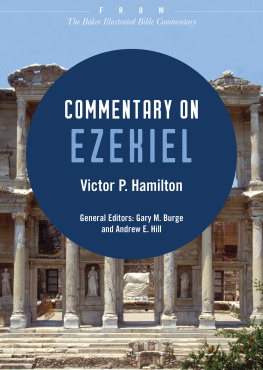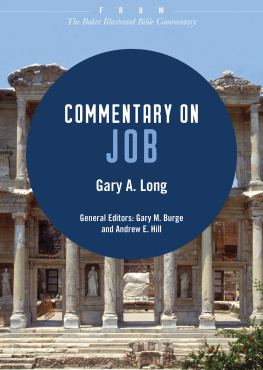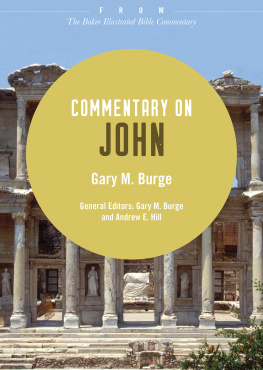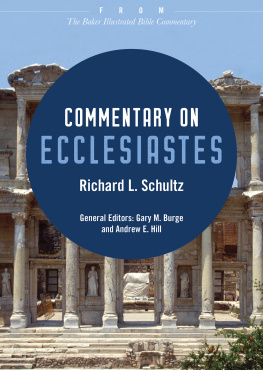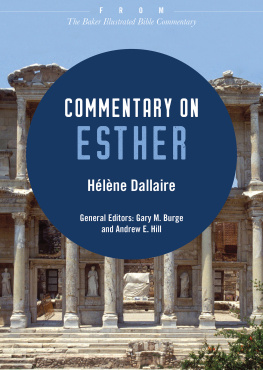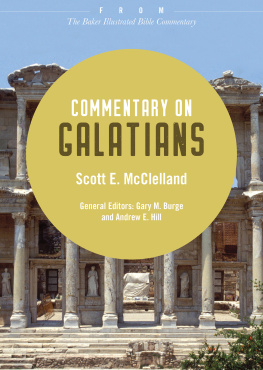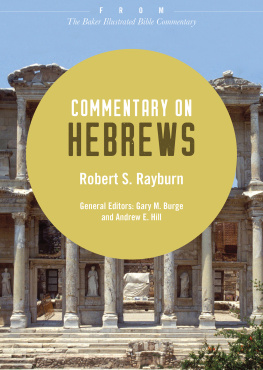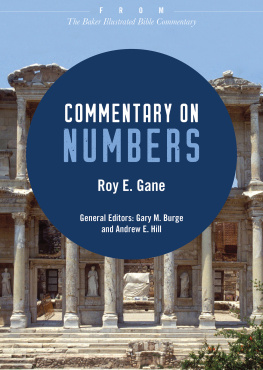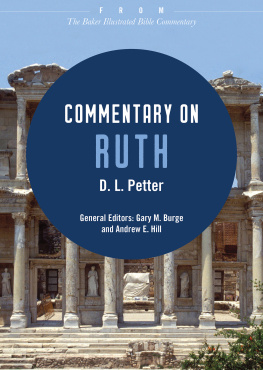Copyright Page
2012 by Baker Publishing Group
Published by Baker Books
a division of Baker Publishing Group
P.O. Box 6287, Grand Rapids, MI 49516-6287
www.bakerbooks.com
Ebook short created 2019
Previously published in The Baker Illustrated Bible Commentary edited by Gary M. Burge and Andrew E. Hill in 2012
All rights reserved. No part of this publication may be reproduced, stored in a retrieval system, or transmitted in any form or by any meansfor example, electronic, photocopy, recordingwithout the prior written permission of the publisher. The only exception is brief quotations in printed reviews.
Library of Congress Cataloging-in-Publication Data is on file at the Library of Congress, Washington, DC.
ISBN 978-1-4934-2462-7
Unless otherwise indicated, Scripture quotations are from the Holy Bible, New International Version. NIV. Copyright 1973, 1978, 1984, 2011 by Biblica, Inc. Used by permission of Zondervan. All rights reserved worldwide. www.zondervan.com. The NIV and New International Version are trademarks registered in the United States Patent and Trademark Office by Biblica, Inc.
Scripture quotations labeled ESV from The Holy Bible, English Standard Version (ESV), copyright 2001 by Crossway, a publishing ministry of Good News Publishers. Used by permission. All rights reserved. ESV Text Edition: 2007
Scripture quotations labeled NASB are from the New American Standard Bible, copyright 1960, 1962, 1963, 1968, 1971, 1972, 1973, 1975, 1977, 1995 by The Lockman Foundation. Used by permission. www.lockman.org
Scripture quotations labeled NIV 1984 are from the HOLY BIBLE, NEW INTERNATIONAL VERSION. NIV. Copyright 1973, 1978, 1984 by International Bible Society. Used by permission of Zondervan. All rights reserved.
Scripture quotations labeled NJPS are from the New Jewish Publication Society Version 1985 by The Jewish Publication Society. All rights reserved.
Scripture quotations labeled NKJV are from the New King James Version. Copyright 1982 by Thomas Nelson, Inc. Used by permission. All rights reserved.
Scripture quotations labeled NLT are from the Holy Bible , New Living Translation, copyright 1996, 2004, 2007 by Tyndale House. Used by permission of Tyndale House Publishers, Inc., Carol Stream, Illinois 60188. All rights reserved.
Scripture quotations labeled NRSV are from the New Revised Standard Version of the Bible, copyright 1989, by the Division of Christian Education of the National Council of the Churches of Christ in the United States of America. Used by permission. All rights reserved.
Scripture quotations labeled RSV are from the Revised Standard Version of the Bible, copyright 1952 [2nd edition, 1971] by the Division of Christian Education of the National Council of the Churches of Christ in the United States of America. Used by permission. All rights reserved.
Unless otherwise indicated, photos, illustrations, and maps are copyright Baker Photo Archive.
Contents
Abbreviations
| ANET | Ancient Near Eastern Texts Relating to the Old Testament . Edited by J. B. Pritchard. 3rd ed. Princeton, 1969 |
| BDAG | Bauer, W., F. W. Danker, W. F. Arndt, and F. W. Gingrich. Greek-English Lexicon of the New Testament and Other Early Christian Literature. 3rd ed. Chicago, 1999 |
| ca. | circa (about, approximately) |
| cf. | compare |
| chap(s). | chapter(s) |
| COS | The Context of Scripture . Edited by W. W. Hallo. 3 vols. Leiden, 1997 |
| e.g. | for example |
| ESV | English Standard Version |
| HALOT | Koehler, L., W. Baumgartner, and J. J. Stamm. The Hebrew and Aramaic Lexicon of the Old Testament. Translated and edited under the supervision of M. E. J. Richardson. 5 vols. Leiden, 19942000 |
| HCSB | Holman Christian Standard Bible |
| i.e. | that is |
| KJV | King James Version |
| NASB | New American Standard Bible |
| NEB | New English Bible |
| NET | New English Translation |
| NIV | New International Version (2011 edition) |
| NIV 1984 | New International Version (1984 edition) |
| NJB | New Jerusalem Bible |
| NJPS | The Tanakh: The Holy Scriptures: The New JPS Translation according to the Traditional Hebrew Text |
| NKJV | New King James Version |
| NLT | New Living Translation |
| NRSV | New Revised Standard Version |
| RSV | Revised Standard Version |
| TDOT | Theological Dictionary of the Old Testament . Edited by G. J. Botterweck and H. Ringgren. Translated by J. T. Willis, G. W. Bromiley, and D. E. Green. 8 vols. Grand Rapids, 1974 |
| TNIV | Todays New International Version |
Hosea
Gary V. Smith
Introduction
Hosea the Prophet
Hoseas personal life was most unusual, for it almost appears that he married the wrong woman. His marriage fell apart when his wife became a prostitute, and eventually he had to buy his wife back from enslavement. One wonders how God can use a prophet with this kind of background. Wouldnt these kinds of personal problems disqualify a person from prophetic service, or was there a good reason why God allowed Hosea to go through these difficulties? Since 1:2 indicates that Hosea and Gomer are symbolic of Gods relationship to Israel, it is evident that God was attempting to teach Hosea, as well as the people he spoke to, a powerful lesson about Gods amazing love for sinful people. God does not give up on people just because they make a mistake; his love is steadfast, he is faithful to his plans, and he is willing to forgive all who repent of their sins.
The book says relatively little about the prophet himself. His father was named Beeri, but no one knows Hoseas occupation before the Lord spoke to him, how old he was, or even where he was born. He repeatedly refers to cities in Israel (Samaria in 7:1; 8:56; 10:5, 7; 13:16; Jezreel in 1:5; Gilgal in 4:15; Mizpah in 5:1; Gibeah in 5:8; 9:9; Bethel in 10:5), and he seems to write in a slightly different Hebrew dialect, so most conclude from this meager evidence that he was born, was raised, and prophesied in and around the Israelite capital of Samaria. He claimed to be a prophet and Gods watchman, but some considered him a fool or an inspired maniac (9:78).
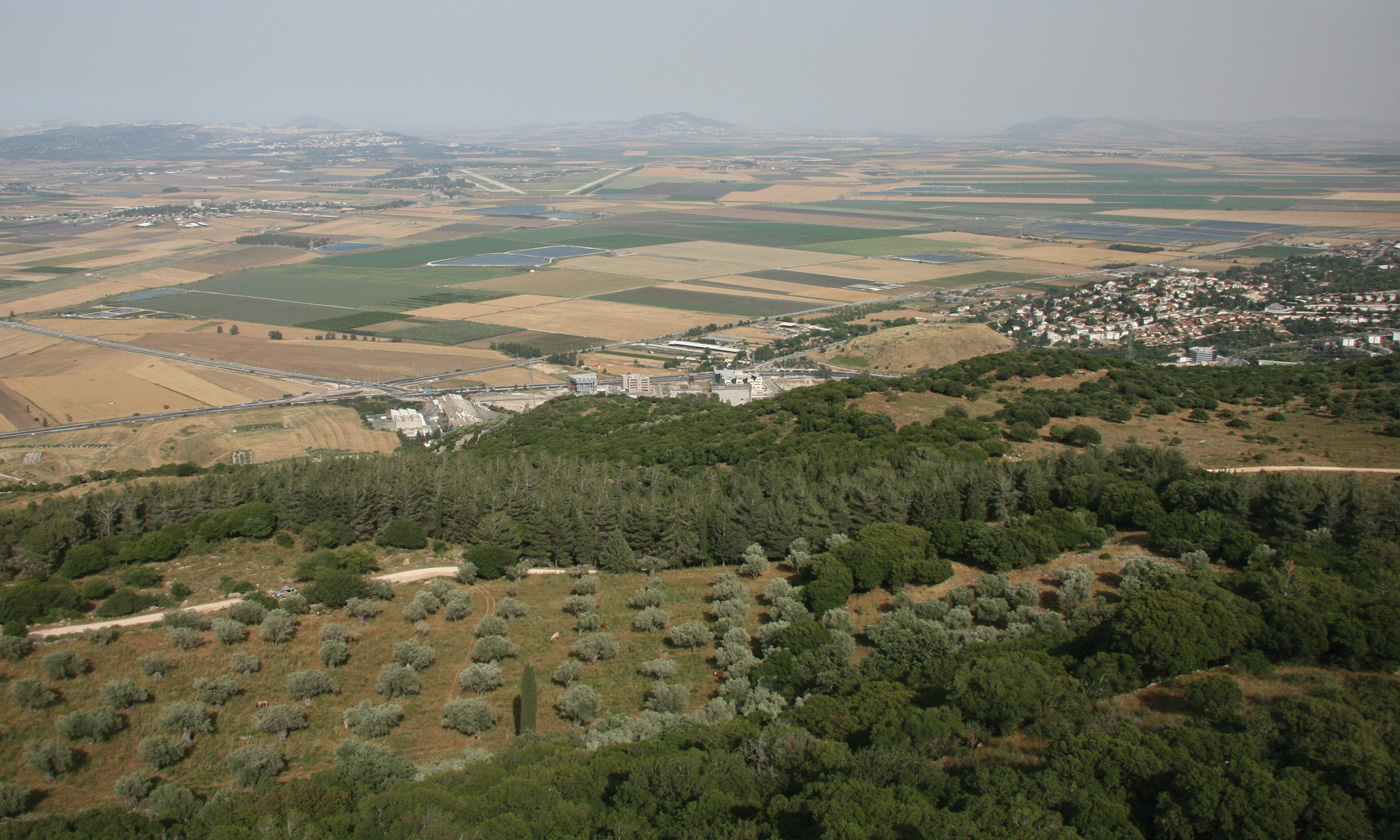
Chapters 13 contain information about Hoseas wife, Gomer the daughter of Diblaim (1:3), his marriage, and his three children, who served as signs of the difficult relationship God had with Israel. In light of all the heartaches and troubles Gomer caused Hosea, it is puzzling why God would ask a godly prophet to marry a woman of adultery/prostitution (NIV a promiscuous woman, 1:2). Because God never asks any other prophet to marry an impure woman like this, because everyone knows that God does not approve of such sinful activity, and because Gomer was unfaithful even after their marriage, some commentators suggest that these odd instructions and events should not be interpreted literally. Instead they hypothesize that chapters 13 report either (1) the spiritual prostitution of Gomer worshiping another god, (2) the report of a dream, (3) the teachings of a parable, or (4) a somewhat risqu drama that was reenacted over and over again in order to teach a spiritual truth. Nevertheless, the narrative report about Hoseas family reads like other historical events; there is no introductory notification informing the reader that this is just a parable or dream (which happens in other places), and there is no interpretation of this so-called parable. Thus it is best to accept this as an autobiographical account of what really happened in the life of Hosea.

